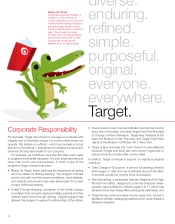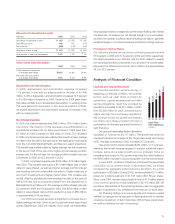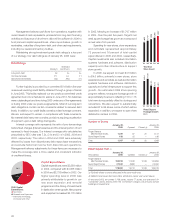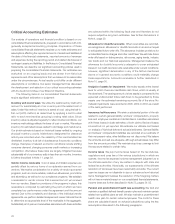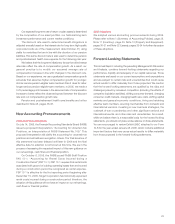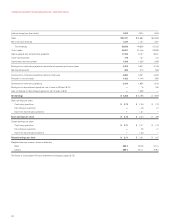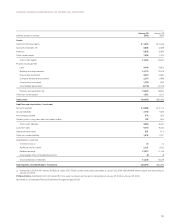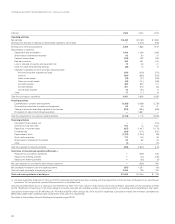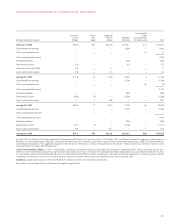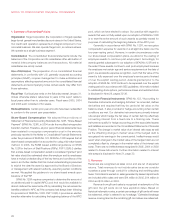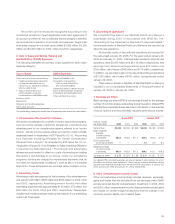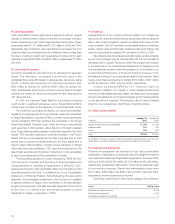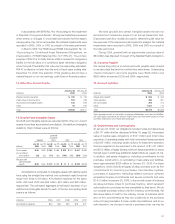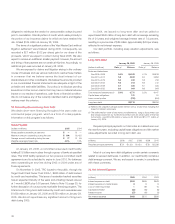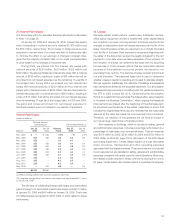Target 2005 Annual Report Download - page 25
Download and view the complete annual report
Please find page 25 of the 2005 Target annual report below. You can navigate through the pages in the report by either clicking on the pages listed below, or by using the keyword search tool below to find specific information within the annual report.
23
Our expected long-term rate of return on plan assets is determined
by the composition of our asset portfolio, our historical long-term
investment performance and current market conditions.
The discount rate used to determine benefit obligations is
adjusted annually based on the interest rate for long-term high-quality
corporate bonds as of the measurement date (October 31) using
yields for maturities that are in line with the duration of our pension
liabilities. This same discount rate is also used to determine pension
and postretirement health care expense for the following plan year.
We believe that the long-term inflationary forces that drive interest
rates also affect the rate of compensation growth. As a result, our
general practice is to modify our assumed average rate of
compensation increase in line with changes in the discount rate.
Based on our experience, we use a graduated compensation growth
schedule that assumes higher compensation growth for younger,
shorter-service pension-eligible team members than it does for older,
longer-service pension-eligible team members. In 2005, we made a
0.75 percentage point increase in the assumed rate of compensation
increase to better reflect the observed spread between the discount
rate and our compensation growth rate.
Pension and postretirement health care benefits are further
described in Note 28, pages 36-38.
New Accounting Pronouncements
2006 and Future Adoptions
On July 14, 2005, the Financial Accounting Standards Board (FASB)
issued a proposed Interpretation, “Accounting for Uncertain Tax
Positions, an Interpretation of FASB Statement No.109.” This
proposed Interpretation will clarify the accounting for uncertain tax
positions and will address recognition criteria. The final issuance of
this statement has been delayed until later in 2006 and the final
effective date for adoption is not known at this time. We are in the
process of assessing the expected impact of this new guidance on
our net earnings, cash flows and financial position.
On October 6, 2005, the FASB issued FASB Staff Position
FAS 13-1, “Accounting for Rental Costs Incurred during a
Construction Period” (FSP 13-1). FSP 13-1 requires that rental costs
associated with ground or building operating leases that are incurred
during a construction period be recognized as rental expense.
FSP 13-1 is effective for the first reporting period beginning after
December 15, 2005. Target Corporation has historically expensed
rental costs incurred during a construction period; therefore, the
adoption of this guidance will not have an impact on our net earnings,
cash flows or financial position.
2005 Adoptions
We adopted various accounting pronouncements during 2005.
Please refer to Note 1 (Summary of Accounting Policies), page 28,
Note 11 (Inventory), page 30, Note 13 (Property and Equipment),
pages 30-31 and Note 22 (Leases), pages 33-34 for further discussion
of these adoptions.
Forward-Looking Statements
This Annual Report, including the preceding Management’s Discussion
and Analysis, contains forward-looking statements regarding our
performance, liquidity and adequacy of our capital resources. Those
statements are based on our current assumptions and expectations
and are subject to certain risks and uncertainties that could cause
actual results to differ materially from those projected. We caution
that the forward-looking statements are qualified by the risks and
challenges posed by increased competition (including the effects of
competitor liquidation activities), shifting consumer demand, changing
consumer credit markets, changing health care costs, shifting capital
markets and general economic conditions, hiring and retaining
effective team members, sourcing merchandise from domestic and
international vendors, investing in new business strategies, the
outbreak of war or pandemics and other significant national and
international events, and other risks and uncertainties. As a result,
while we believe there is a reasonable basis for the forward-looking
statements, you should not place undue reliance on those statements.
You are encouraged to review Exhibit (99)C attached to our Form
10-K for the year ended January 28, 2006, which contains additional
important factors that may cause actual results to differ materially
from those projected in the forward-looking statements.



